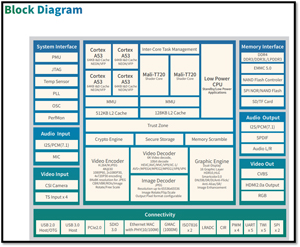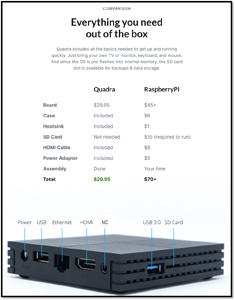In-Depth
Interview with the Creator of the Inovato Quadra (Low-Priced Raspberry Pi Alternative)
Over the past months, I have written a fair bit about the Inovato Quadra, an inexpensive, ultra-small form factor computer based on a four-core Arm processor. I found the device to be very capable at -- to be honest -- an outstanding price point. During that time, I have had a few email interactions with Michael Burmeister-Brown, the creator of the Quadra and the owner of Inovato, the company that sells the device. Below is a summary of those conversations.
Before starting out with this article, Michael did point out that in one of my earlier articles, I mentioned that it uses an Amlogic SOC. It doesn't; it uses an Allwinner H6 which is in the same class as the Amlogic SOC. This information is on the Inovato web site. Those who want in-depth information can find it here.
 [Click on image for larger view.]
[Click on image for larger view.]
I asked Michael what use cases he had in mind for the device -- why people would buy it and what they would use it for.
Honestly, I felt the last series went a bit off track focusing on pushing it vs. why folks would buy it and how they use it. As an analogy, I recently bought a Chevy Bolt as I wanted an electric car that had good range and didn't want to spend more than I had to. Sure, it isn't a Tesla, but I didn't want to pay Tesla prices. So, I got a car I love and spent half the price -- money I can use for other priorities. Would it compare well to a Tesla at the high end? No. But I don't care how fast it can do 0-60. Or how fast it charges. I charge it in my garage overnight on 110v and even that works fine -- it is almost always fully charged in the morning. Anyway, that is what we set out to do with the Quadra. The goal was to build the best under $30 computer we could that was complete, not the best computer period. Like the Chevy Bolt, it is less than half the price of a built-out Raspberry Pi (even assuming you could get them at retail prices).
 [Click on image for larger view.]
[Click on image for larger view.]
Specifically, we really encourage people NOT to use it for video or other things that really tax the CPU. Even the fan is sort of a project we did for people who insist. But it isn't what we really want to encourage as it still isn't going to perform as well as a Pi 4 or standard Android TV box for video. Those are use cases where another device is a better purchase.
Which gets into your last question, what is it best for?
The Projects section of our forum is a good place to start, but really anything that isn't highly CPU intensive should work fine. So, think of any type of server or desktop apps that aren't CPU intensive.
Some things that I see come up often are:
- Ham radio (which is still a work in progress to get all the apps working). But unless you are into this, it is not easy to write about.
- 3D printing. Klipper comes up a lot (and seems to work well for folks) to improve their 3D print quality. But again, you need a 3D printer.
- Topics I personally like are using it for learning. As we say in the site headline for "home, hobby, schools." I saw an interesting post the other day here about running Kolibri micro-server on Quadra. I haven't looked at it yet but seems quite interesting and spot on target.
What else would you like Quadra to do?
I want to do a series on learning to program if no one else does. There are so many good IDEs and learning programs out there. It even makes a great development system for Arduino.
And of course, there are things that fall into the home/hobby category. There are articles on setting up web servers or plex media servers, etc.
And I use it with standard security cameras to view remotely. See the article on Tailscale on the forums. This is a really cool "overlay network" that gives you secure static IPs for your remote computer. Install it on the Quadra (and on your local PC), and you can now reach the Quadra from anywhere. No more port forwarding. Using their subnet router feature, you can even access ALL devices on the remote network. So, your security cameras act as if they are local. You don't need to setup any other software. The free software the cameras come with will work just fine. FYI, I also put a USB temperature sensor on it and dropped it under the house so I can monitor temperatures around the pipes.
As we say in the PI comparison article, the Quadra is best used anywhere where a PI 4 is overkill, and you want something inexpensive and preassembled that can do the job. The Quadra is not designed to "kill" the PI4. But there are a lot of places where you could save money and time with something like the Quadra. Plus, it was (and is) fun to see just how far we can take this thing. The Pi has a many years' head start, but people are supporting the Quadra more and more. We are only 2 months in....
While looking and testing the device and pushing it beyond its intended use cases (see above) I found that it overheated especially when playing videos. This confused me as the devices were originally designed as a TV set-top box, that's main purpose would be playing videos.
The answer boils down to TV boxes run Android built by Google and generally use older kernels (at least compared to Linux mainline). Google doesn't do driver updates for every kernel version, and what is done is often slow to port into the mainline kernel. So, the tradeoff becomes "build off mainline" and have whatever kernel you want to build, or "build only with specific older kernels." In the Linux world, that is less than desirable as most of the time most SBCs aren't used for watching YouTube. You introduce incompatibilities with software that expects a recent kernel and lose security updates. And with Armbian (the best distro I have found for supporting SBC computers), old kernels are often not maintained and won't be built. We needed to use an OS that we could count on moving forward.
Having said all that, things often ultimately do get ported back and I have heard rumors that kernel 6.1 has some improvements. So, things can get better with time on that front. I just wouldn't ever advise folks to count on it.
Since our user base is really not geared toward watching YouTube, we elected to go with a mainline kernel.
I continue to be impressed with Inovato Quadra and the person behind this project, Michael. It is a solid piece of hardware at an incredible price point. As more and more people discover its power, we will see more projects and tutorials on it. I am especially excited about its future in education as it is inexpensive enough to allow each student to have their own device to work with.
About the Author
Tom Fenton has a wealth of hands-on IT experience gained over the past 30 years in a variety of technologies, with the past 20 years focusing on virtualization and storage. He previously worked as a Technical Marketing Manager for ControlUp. He also previously worked at VMware in Staff and Senior level positions. He has also worked as a Senior Validation Engineer with The Taneja Group, where he headed the Validation Service Lab and was instrumental in starting up its vSphere Virtual Volumes practice. He's on X @vDoppler.